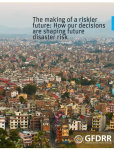The world is unprepared for an increasing rise in disasters, resulting from climate change, rising populations and greater vulnerability of those living in big cities and unregulated housing, according to a report by the Global Facility for Disaster Reduction and Recovery (GFDRR).
The report calls for a radical new approach to assessing risk that accounts for rapid changes in global disaster risk.
 16 May 2016: The world is unprepared for an increasing rise in disasters, resulting from climate change, rising populations and greater vulnerability of those living in big cities and unregulated housing, according to a report by the Global Facility for Disaster Reduction and Recovery (GFDRR). The report calls for a radical new approach to assessing risk that accounts for rapid changes in global disaster risk.
16 May 2016: The world is unprepared for an increasing rise in disasters, resulting from climate change, rising populations and greater vulnerability of those living in big cities and unregulated housing, according to a report by the Global Facility for Disaster Reduction and Recovery (GFDRR). The report calls for a radical new approach to assessing risk that accounts for rapid changes in global disaster risk.
‘The Making of a Riskier Future: How Our Decisions are Shaping the Future of Disaster Risk’ contends that, without future planning for cities and coastal areas that takes into account potential disasters, the world is risking increased future losses. The report brings together case studies and existing literature to show how densely populated coastal cities are sinking. It cautions that, when coupled with rising sea levels, annual loses from disasters in 136 coastal cities could increase to US$6 billion in 2010 to US$1,000 billion in 2070. By 2050, population growth and rapid urbanization could result in 1.3 billion people and US$158 trillion in assets at risk from river and coastal floods, according to the report.
The report describes drivers of evolving disaster risk related to various hazards, including hydrometeorological hazards (tropical cyclones, extratropical cyclones, flooding, extreme heat, droughts and wildfires) and geotechnical and geophysical hazards (seismic and volcanic hazards, and landslides). It also discusses drivers related to exposure, including population growth, increased socioeconomic activity, land-use change and data on evolving exposure, and vulnerability-related drivers, including structural and social vulnerability.
A chapter on quantifying the evolution of disaster risk addresses, inter alia, uncertainty in risk assessment and in exposure data and projections; use of climate projections in disaster risk assessment; and use of socioeconomic scenarios to project population. The report identifies policies to increase future resilience related to: mitigating climate change; managing urbanization; managing risk through construction; considering ecosystem-based risk management; improving data for risk modeling; implementing robust, flexible adaptation; enhancing disaster resilience; and planning recovery and reconstruction in advance.
The GFDRR and the World Bank have also released ‘ThinkHazard!’ an open-source platform open-source platform that provides information on eight hazards for 196 countries and presents recommendations on reducing risk across these hazards, namely: earthquakes; coastal and river floods; tsunamis; cyclones; water scarcity; volcanoes and landslides. The platform aims to provide reliable, accessible risk information to support effective disaster risk management (DRM).
The GFDRR, managed by the World Bank, is a global partnership that helps developing countries better understand and reduce vulnerabilities to natural hazards and adapt to climate change. It provides grant financing, technical assistance, training and knowledge sharing activities to mainstream disaster and climate risk management into policies and strategies. [World Bank News Story] [Publication: The Making of a Riskier Future: How Our Decisions are Shaping the Future of Disaster Risk] [ThinkHazard! Website] [2016 Understanding Risk Forum Website]